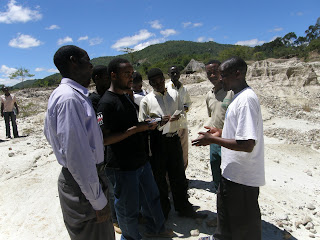
A lion at Ruaha National park
The scenery and the topography of the country, including its very friendly people, harbours the growth of excellent cultural tourism, beach holidays, game hunting, historical and archaeological ventures and certainly the best wildlife photographic safaris on the continent. Tanzania is home to the leading wildlife reserves including the largest national park in the world, Serengeti and the second highest mountain in the world, Mt. Kilimanjaro. All these provide for matches locations for investment. The Tourism division in the Tanzanian Ministry of Tourism and Natural Resources was established in 1970 to carry out the present duties of ensuring development of tourism industry in Tanzania. Tourism industry as one of the sectors of the Tanzania’s economy, has experienced tremendous growth after the advent of the liberalization ten years ago, this is dedicated to foster a structured tourism development. Tanzanian government has developed a National Tourism Policy which is a guide towards development of tourism sector in the country. The objective of the policy is to assist on efforts to promote the economy and improve the livelihood of the people. Basically, tourism policy provides strategies necessary to ensure sustainable tourism development in the country.

Elephants in groups at Mikumi national park
Other efforts include encouragement of the private sector to participate in the development of tourism through encouraging investments by giving investment incentives. The importance of tourism to Tanzanian national economy, is presently termed as significant. There is hope that this kind of tourism will grow further in the future because since early in 2002 Tanzanian government has finalized master plans.
Tourism Master Plan (TMP) strategy and actions is now in place and this looks at the important areas for preservation and development of historical sites. Such areas are Isimila Stone Age site, Lugalo and Kalenga war sites in Iringa region in Southern Highland. Others are Bagamoyo, Kilwa Kisiwani, and rock paintings of Kondoa Irangi.
Statistics made available from the Directorate of Tourism in the country, shows that, while in 1990 foreign exchange from tourism amounted to only 65 million US$ it has shot up to US$ 739 million within a space of ten years up to 2000, almost one hundred percent increase. The current statistics made available by Tanzania Tourist Board (TTB) shows that, between 2001 and December 2008, the increase of tourist arrivals in the country has shot up by 75 percent. Despite of the important roles played by hotels in the development of the sector in Tanzania, the sector is still confronted by a number of problems with the southern circuit mostly hit.

These are such types of vehicles designed with an open space on top of their bodies used by tourists while at the national parks viewing animals
Under human resource development strategy, Tanzania has insufficient trained personnel in its tourism sector and this is acute at supervisory and management levels. Tourism is a service industry and delivering a quality service is a prerequisite to ensuring that the customer obtains value for money. The Hotel Keepers Association of Tanzania says that, since there is no rationale between the increase of hotels in the country and the hotel training centers, prospects for tourism sector in Tanzania has shown a remarkable development feature in the last two years. Apart from this rationale, there is also major factors as hindrances which comes from the inconsistencies in water and electricity supply to the hotels, poor infrastructure particularly the road network leading to tourist national parks and beaches along with inefficient communication and information facilities such as internet, expensive reliable energy, the provision of telephones services whose tariffs are so high. In spite of all these, tourism development has remained strong and accounts for more than 14 percent of the Tanzania’s Gross Domestic Product (GDP) and is expected to grow by more than 5 percent a year in real terms through 2020.

A tourist hotel at Kitulo national park in Makete district, Iringa region.
The growth of tourism sub sector in Tanzania is also encouraging going by the available data. The revenue collected in Tanzania from tourism business has increased, and the number of tourists, who visited Tanzania has increased from 501,669 in 2003 to 825,122 in 2008. During the trading period, big tourist hotels in Tanzania played the most crucial role in promoting the industry by providing accommodation to the visitors. The revenue collected from the tourism business also increased by far. In Spite of this increase in revenue from tourism, the number of tourist hotels in the country increased also. The increase in number of hotels logically increased the number of hotel rooms and beds available to tourists. The average numbers of days spent by tourists in Tanzania however increased correspondingly according to the demand. The only part of tourism, which enlisted a higher growth rate was cultural tourism, archives and antiquities.






















